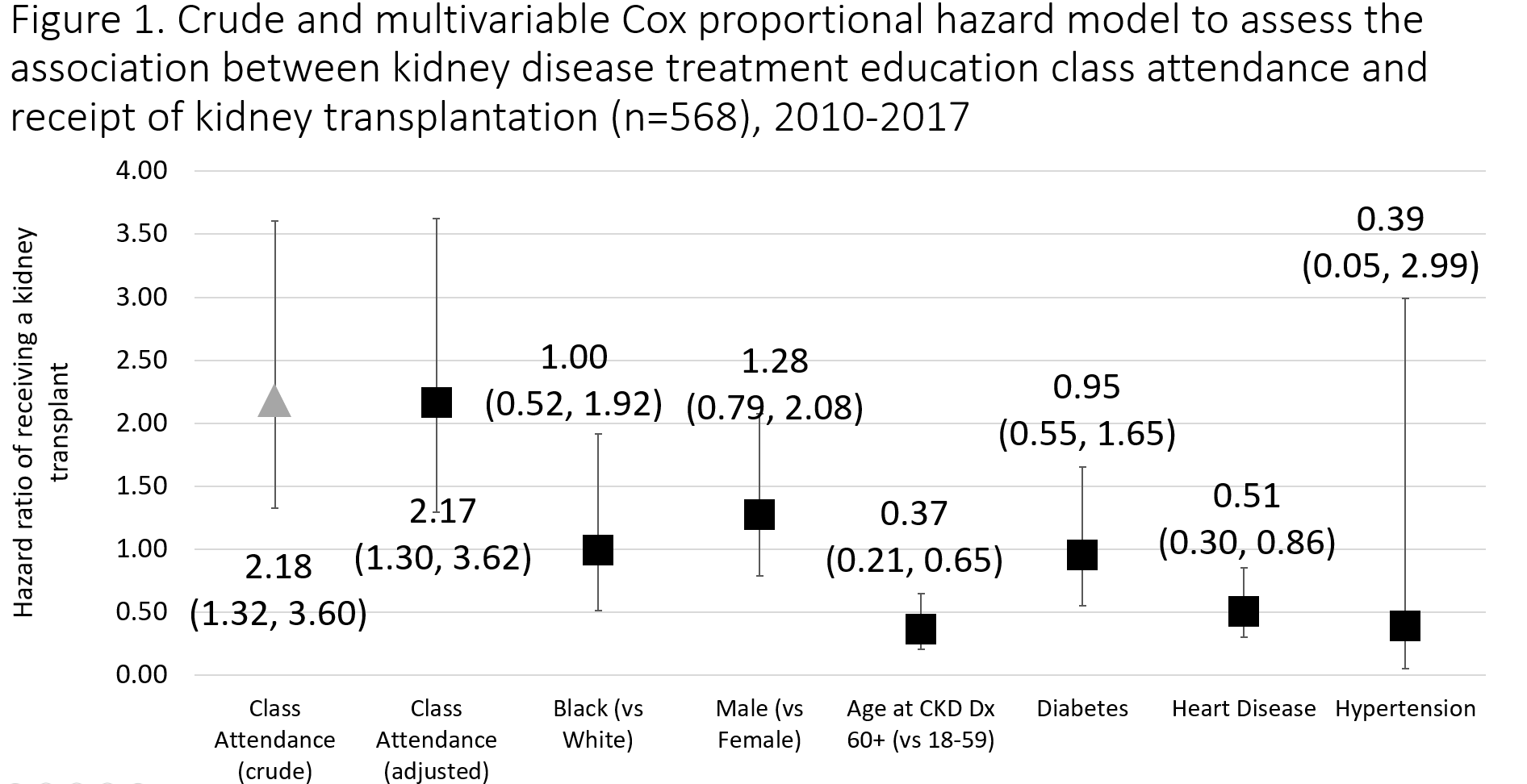Association between a Chronic Kidney Disease Treatment Education Class and Receipt of a Kidney Transplantation in the Southeastern U.S. Population
1Kaiser Permanente, Atlanta, GA, 2Emory University, Atlanta, GA
Meeting: 2019 American Transplant Congress
Abstract number: 617
Keywords: Kidney transplantation, Patient education, Risk factors
Session Information
Session Name: Concurrent Session: Non-Organ Specific: Disparities and Access to Healthcare II
Session Type: Concurrent Session
Date: Tuesday, June 4, 2019
Session Time: 4:30pm-6:00pm
 Presentation Time: 5:18pm-5:30pm
Presentation Time: 5:18pm-5:30pm
Location: Room 208
*Purpose: Predialysis education is associated with improved patient survival and improved access to kidney transplantation (KT), however many of the findings are based on a dialysis facility’s nephrologist’s report when starting dialysis. We aimed to utilize chronic kidney disease (CKD) clinics’ electronic medical record data to objectively determine if predialysis education was positively associated with receipt of KT in a Southeastern, privately insured population.
*Methods: We identified 568 Black or White adults (age≥18) with CKD late stage 4-5 referred to a free, one-time CKD treatment education class from January 1, 2010- October 31, 2017 to allow for a full year of follow-up. We used a virtual data warehouse to identify their KT status. Crude and multivariable Cox proportional hazard models determined the association between class attendance and KT. Time-to-event was defined as time from CKD class to time of KT, censored at death or end of follow-up.
*Results: CKD patients referred for the class (n=568) were 55.6% male, 76.6% Black, and aged 58.9 years (mean), and only 12.3% (n=70) received a KT, with a median follow-up time from class to KT was 4.4 (IQR 2.8, 5.8) years. Among the 304 (53.5%) that attended the CKD class, 53.3% were male, 78.6% were Black, and 75.0% were diagnosed with diabetes, and 14.1% (n=43) received a KT. Class attendance improved receipt of KT two-fold (crude HR=2.18; 95% CI 1.32, 3.60 and multivariable HR=2.17; 95% CI 1.30, 3.62). In the multivariable analysis, there was no difference in access to KT by race (HR=1.00; 95% CI 0.52, 1.92) or gender (HR=1.28; 95% CI 0.79, 2.08). Patients age≥60 and diagnosed with heart disease were less likely to receive a KT.
*Conclusions: CKD treatment education was associated with improved access to KT while controlling for patient characteristics. Efforts to improve CKD education need to continue while public health researchers and community members continue to strive to reach patients who do not, or cannot, attend in-person treatment education classes.
To cite this abstract in AMA style:
Gander JC, Cromwell L, Wilk AS, Patzer RE, Sesay M, Walker-Williams D, Davis T, Austin JP, Mukerji N. Association between a Chronic Kidney Disease Treatment Education Class and Receipt of a Kidney Transplantation in the Southeastern U.S. Population [abstract]. Am J Transplant. 2019; 19 (suppl 3). https://atcmeetingabstracts.com/abstract/association-between-a-chronic-kidney-disease-treatment-education-class-and-receipt-of-a-kidney-transplantation-in-the-southeastern-u-s-population/. Accessed December 26, 2025.« Back to 2019 American Transplant Congress

